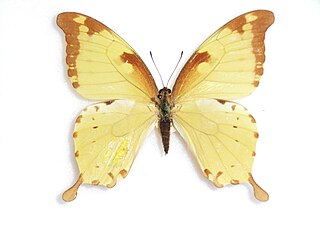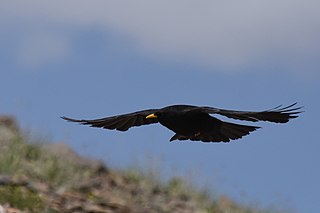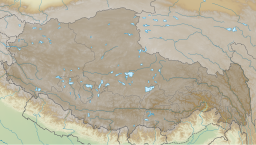
The Himalayas, or Himalaya, is a mountain range in Asia, separating the plains of the Indian subcontinent from the Tibetan Plateau. The range has some of the Earth's highest peaks, including the highest, Mount Everest; over 100 peaks exceeding elevations of 7,200 m (23,600 ft) above sea level lie in the Himalayas.
The McGraw-Hill Encyclopedia of Science & Technology is an English-language multivolume encyclopedia, specifically focused on scientific and technical subjects, and published by McGraw-Hill Education. The most recent edition in print is the eleventh edition, copyright 2012 (ISBN 9780071778343), comprising twenty volumes. The encyclopedia covers the life sciences and physical sciences, as well as engineering and technology topics. The content is also available via a subscription to McGraw-Hill Education's website.

The Tibetan Plateau, also known as the Qinghai–Tibet Plateau or the Qing–Zang Plateau or as the Himalayan Plateau in India, is a vast elevated plateau located at the intersection of Central, South and East Asia covering most of the Tibet Autonomous Region, most of Qinghai, western half of Sichuan, Southern Gansu provinces in Western China, southern Xinjiang, Bhutan, the Indian regions of Ladakh and Lahaul and Spiti as well as Gilgit-Baltistan in Pakistan, northwestern Nepal, eastern Tajikistan and southern Kyrgyzstan. It stretches approximately 1,000 kilometres (620 mi) north to south and 2,500 kilometres (1,600 mi) east to west. It is the world's highest and largest plateau above sea level, with an area of 2,500,000 square kilometres (970,000 sq mi). With an average elevation exceeding 4,500 metres (14,800 ft) and being surrounded by imposing mountain ranges that harbor the world's two highest summits, Mount Everest and K2, the Tibetan Plateau is often referred to as "the Roof of the World".

A meromictic lake is a lake which has layers of water that do not intermix. In ordinary, holomictic lakes, at least once each year, there is a physical mixing of the surface and the deep waters.

Lake Mansarovar, also called Mapam Yumtso locally, is a high altitude freshwater lake fed by the Kailash Glaciers near Mount Kailash in Burang County, Ngari Prefecture, Tibet Autonomous Region, China. The lake along with Mount Kailash to its north are sacred sites in four religions: Hinduism, Jainism, Buddhism and Bön.

Lake Rakshastal is a saltwater lake in Tibet Autonomous Region, China, lying just west of Lake Manasarovar and south of Mount Kailash. The Sutlej River originates at Rakshastal's northwestern tip.

Gurudongmar Lake is one of the highest lakes in the world and in India, at an elevation of 5,430 m (17,800 ft) according to the Government of Sikkim. It is located in the Great Himalayas in the Mangan District in Indian state of Sikkim, and considered sacred by Buddhists, Sikhs and Hindus. The lake is named after Guru Padmasambhava—also known as Guru Rinpoche—founder of Tibetan Buddhism, who visited in the 8th century.

Ferdinand Christian Gustav Arnold was a German lichenologist and taxonomist born in Ansbach, Bavaria. Even as a high school student he showed an active interest in botany: "Ich und August Gattinger ... durchstreiften von November 1846 bis zum Spätherbst 1847, Pflanzen sammelnd, die Landschaft von München nach allen Richtungen.".

Hygrobia is a genus of aquatic beetles native to Europe, North Africa, China and Australia. It is the only genus in the family Hygrobiidae, also known as the Paelobiidae. These are known commonly as squeak beetles or screech-beetles.

Papilio nobilis, the noble swallowtail, is a butterfly of the family Papilionidae. It is found in Africa.

Organisms can live at high altitude, either on land, in water, or while flying. Decreased oxygen availability and decreased temperature make life at such altitudes challenging, though many species have been successfully adapted via considerable physiological changes. As opposed to short-term acclimatisation, high-altitude adaptation means irreversible, evolved physiological responses to high-altitude environments, associated with heritable behavioural and genetic changes. Among vertebrates, only few mammals and certain birds are known to have completely adapted to high-altitude environments.
The Mkuzu or Mkusu is a river of northeastern Tanzania. The Magamba Forest Reserve forms part of the landscape and there is a notable waterfall along the river named the Soni Falls, where the Mkuzu joins the Bangala River. The river also flows through the village of Kifungilo.
Amphizoa sinica is a species of beetle in the Amphizoidae family. The length of its body is between 11 and 13.5 millimeters. Its metasternal process is depressed, with the lateral margin raised. It lives in the northeastern province of Jilin in China and in North Korea.
Amphizoa davidis is a species of beetle in the Amphizoidae family described by the entomologist Hippolyte Lucas in 1882. The beetle measures between 10.5 and 16 millimeters in length. Its elytra are most notable for lacking a carina on the fifth interval. The pronotum has a lateral margin without lateral bead. The species is only known from the province Sichuan of in especially in China.
Ochthebius puncticollis is a species of minute moss beetle in the family Hydraenidae. It is found in Central America and North America.

Ochthebius is a genus of minute moss beetles in the family Hydraenidae. There are at least 460 described species in Ochthebius.
Ochthebius lineatus is a species of minute moss beetle in the family Hydraenidae. It is found in Central America, North America, and South America.
Ochthebius marinus, the marine moss beetle, is a species of minute moss beetle in the family Hydraenidae. It is found in Europe and Northern Asia, North America, and Southern Asia.

Epimetopidae is a family of semi-aquatic beetles belonging to the Hydrophiloidea. They are found in sand and gravel at the edges of streams, rivers and shallow freshwater ponds. These beetles are shorter than half a centimeter long and have a pronotum with a central projection forming a shelf above the head. On the underside of the abdomen only four sternites are visible. There are approximately 72 described species in three genera, Epimetopus which is restricted to the New World, mostly Neotropical, Eupotemus with two Afrotropical species and Eumetopus with some Oriental species. Females carry their eggcases on the underside of the abdomen. The larvae are probably carnivorous based on their mouthparts and likely live in the same habitats as the adults.
Hydrovatus rufoniger, is a species of predaceous diving beetle found in India, Bangladesh, Myanmar, Sri Lanka, China, Sumatra, Malaysia, Singapore, Thailand, Vietnam and Australian region.














